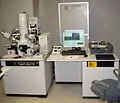Nuclear engineering
Nuclear engineering is the branch of engineering concerned with the application of breaking down atomic nuclei (fission) or of combining atomic nuclei (fusion), or with the application of other sub-atomic processes based on the principles of nuclear physics. In the sub-field of nuclear fission, it particularly includes the design, interaction, and maintenance of systems and components like reactors, power plants, or weaponry. The field also includes the study of medical and other applications of radiation, particularly Ionizing radiation, nuclear safety, heat/thermodynamics transport, nuclear fuel, or other related technology (e.g., radioactive waste disposal) and the problems of nuclear proliferation. This field also includes chemical engineering and electrical engineering.[1]
Professional areas
The United States currently generates about 20% of its electricity from nuclear power plants. Nuclear engineers in this field generally work, directly or indirectly, in the nuclear power industry or for national laboratories.[2] Current research in the industry is directed at producing economical and proliferation-resistant reactor designs with passive safety features. Some government (national) labs provide research in the same areas as private industry and in other areas such as nuclear fuels and nuclear fuel cycles, advanced reactor designs, and nuclear weapon design and maintenance. A principal pipeline/source of trained personnel (both military and civilian) for US reactor facilities is the US Navy Nuclear Power Program, including its Nuclear Power School in South Carolina. Employment in nuclear engineering is predicted to grow about nine percent in the year 2022 as needed to replace retiring nuclear engineers, provide maintenance and updating of safety systems in power plants, and to advance the applications of nuclear medicine.[3][4][5]
 Nuclear powerplant
Nuclear powerplant.jpg.webp) B-61 thermonuclear weapon
B-61 thermonuclear weapon
Nuclear medicine and medical physics
Medical physics is an important field of nuclear medicine; its sub-fields include nuclear medicine, radiation therapy, health physics, and diagnostic imaging.[6] Highly specialized and intricately operating equipment, including x-ray machines, MRI and PET scanners and many other devices provide most of modern medicine's diagnostic capability—along with disclosing subtle treatment options.[7][8]
 X-Ray image of a male skull
X-Ray image of a male skull Magnetic Resonance Imaging (MRI) scan of a human head
Magnetic Resonance Imaging (MRI) scan of a human head PET scan taken with an ECAT Exact HR+PET scanner
PET scan taken with an ECAT Exact HR+PET scanner
Nuclear materials
Nuclear materials research focuses on two main subject areas, nuclear fuels and irradiation-induced modification of nuclear materials. Improvement of nuclear fuels is crucial for obtaining increased efficiency from nuclear reactors. Irradiation effects studies have many purposes, including studying structural changes to reactor components and studying nano-modification of metals using ion-beams or particle accelerators.[9]
 Uranium ore, the principal raw material of nuclear fuel
Uranium ore, the principal raw material of nuclear fuel Nuclear fuel pellets
Nuclear fuel pellets A focused ion beam
A focused ion beam
Radiation protection and measurement
Radiation measurement is fundamental to the science and practice of radiation protection, sometimes known as radiological protection, which is the protection of people and the environment from the harmful effects of uncontrolled radiation.[10]
Nuclear engineers and radiological scientists are interested in developing more advanced ionizing radiation measurement and detection systems, and using these advances to improve imaging technologies; these areas include detector design, fabrication and analysis, measurements of fundamental atomic and nuclear parameters, and radiation imaging systems, among others.
 A modern Geiger counter
A modern Geiger counter A neutron detector
A neutron detector Scintillation detector next to uraninite
Scintillation detector next to uraninite Hand-held large area alpha scintillation probe under calibration
Hand-held large area alpha scintillation probe under calibration Hand-held integral ion chamber survey meter in use
Hand-held integral ion chamber survey meter in use
Nuclear engineering organizations
- American Nuclear Society
- International Atomic Energy Agency
- Nuclear Institute (UK)
See also
- Atomic engineering
- Atomic physics
- Black Swan theory
- Brittle Power
- Chernobyl nuclear disaster
- Earthquake engineering
- Fukushima nuclear disaster
- International Nuclear Event Scale
- List of books about nuclear issues
- Lists of nuclear disasters and radioactive incidents
- List of nuclear reactors
- Megaprojects and Risk
- Normal Accidents
- Northeast Blackout of 2003
- Nuclear fuel
- Nuclear criticality safety
- Nuclear material
- Nuclear Measurements Corporation
- Nuclear physics
- Nuclear power
- Nuclear reactor technology
- Nuclear renaissance
- Project Gnome
- Safety engineering
- Thermal hydraulics
- Three Mile Island: A Nuclear Crisis in Historical Perspective
- Waste Isolation Pilot Plant
References
- "Nuclear Engineers : Occupational Outlook Handbook: : U.S. Bureau of Labor Statistics". www.bls.gov. Retrieved 2019-12-13.
- "Nuclear engineer job profile | Prospects.ac.uk". www.prospects.ac.uk. Retrieved 2019-12-13.
- "Nuclear Engineers – Job Outlook" in Occupational Outlook Handbook, 2014–15. Bureau of Labor Statistics, U.S. Department of Labor
- "Nuclear Engineers: Jobs, Career, Salary and Education Information". collegegrad.com. Retrieved 2019-12-13.
- "Nuclear Engineer Job Description, Career as a Nuclear Engineer, Salary, Employment - Definition and Nature of the Work, Education and Training Requirements, Getting the Job". careers.stateuniversity.com. Retrieved 2019-12-13.
- Medical Physicist. American Association of Physicists in Medicine
- "Physicist - Careers in Nuclear Medicine - SNMMI". www.snmmi.org. Retrieved 2019-12-13.
- "Human Health Campus - Dosimetry and Medical Physics". humanhealth.iaea.org. Retrieved 2019-12-13.
- "Nuclear Materials". U.S.N.R.C. 2019-01-05.
- Valentin, J. (2005-01-07). "Protecting people against radiation exposure in the event of a radiological attack". Annals of the ICRP. 35 (1): 1–41. doi:10.1016/j.icrp.2005.01.002. ISSN 0146-6453.
Further reading
- Ash, Milton, "Nuclear reactor kinetics", McGraw-Hill, (1965)
- Gowing, Margaret. Britain and Atomic Energy, 1939–1945 (1964).
- Gowing, Margaret, and Lorna Arnold. Independence and Deterrence: Britain and Atomic Energy, Vol. I: Policy Making, 1945–52; Vol. II: Policy Execution, 1945–52 (London, 1974)
- Johnston, Sean F. "Creating a Canadian Profession: The Nuclear Engineer, 1940–68," Canadian Journal of History, Winter 2009, Vol. 44 Issue 3, pp 435–466
- Johnston, Sean F. "Implanting a discipline: the academic trajectory of nuclear engineering in the USA and UK," Minerva, 47 (2009), pp. 51–73
